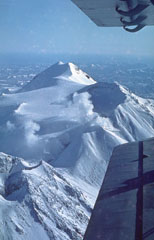Report on Zhupanovsky (Russia) — August 1993
Bulletin of the Global Volcanism Network, vol. 18, no. 8 (August 1993)
Managing Editor: Edward Venzke.
Zhupanovsky (Russia) Fumarolic emissions from active crater
Please cite this report as:
Global Volcanism Program, 1993. Report on Zhupanovsky (Russia) (Venzke, E., ed.). Bulletin of the Global Volcanism Network, 18:8. Smithsonian Institution. https://doi.org/10.5479/si.GVP.BGVN199308-300120
Zhupanovsky
Russia
53.589°N, 159.15°E; summit elev. 2899 m
All times are local (unless otherwise noted)
An overflight by members of SVE on 24 August 1993 revealed that significant fumarolic activity was present in the summit area. Fumarolic emissions were coming from the active crater, as well as from other parts of the summit ridge W of the second cone's crater. Yellow sulfur deposits were visible at several locations.
Geological Summary. The Zhupanovsky volcanic massif consists of four overlapping stratovolcanoes along a WNW-trending ridge. The elongated complex was constructed within a Pliocene-early Pleistocene caldera whose rim is exposed only on the eastern side. Three of the stratovolcanoes were built during the Pleistocene. An early Holocene stage of frequent moderate and weak eruptions from 7,000 to 5,000 years before present (BP) was followed by a period of infrequent larger eruptions that produced pyroclastic flows. The last major eruption took place about 800-900 BP. Recorded eruptions have consisted of relatively minor explosions from Priemysh, the third cone from the E about 2.5 km from the summit peak.
Information Contacts: H. Gaudru, SVE, Switzerland.

